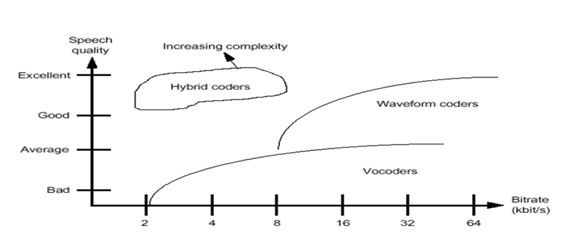GSM Transmission Process and Steps
Analog to digital conversion takes place in 3 steps:
1.
Sampling
2.
Quantization
3.
Coding
Visit our Facebook Page
Coding involves converting the quantized values into binary.
Every value is represented by a binary code of 13 bits (2 13= 8192).
The output rate of the A/D Conversion process is:
•8000
Samples/Sec x 13 bits/Sample = 104 Kb/s
•If
one frequency will be used for 8 calls, then the bit rate will be:
•8
x 104 kb/s = 832 kb/s this will not fit in the 200 KHz channel allocated for
one frequency.
So,
Coding should be used to reduce the rate
Segmentation
•The
voice compression coding technique is widely used in the modern digital
communication systems.
•In
this technique, a voice coder is used to set up a model to simulate the voice
and noise produced by human vocal organs.
•The
parameters to form the model will be transmitted through the TCH channels.
•The
voice coder is based on the residual excited linear prediction (REIP) coder.
Moreover, the long term predictor (LTP) is used to enhance the compression
effect. LTP can make the coding of residual data more advantageous by removing
the vowels from the voice.
•With
20ms as the unit, the voice coder outputs 260bits after compressed coding.
Therefore, the code rate is 13kbps.
Visit our Facebook Page
Speech Coding
•Many
types of speech coders are available. Some offer better speech quality, at the
expense of a higher bit rate (waveform coders). Others use lower bit rates, at
the expense of lower speech quality (Vocodor).
•The
hybrid coder used by GSM provides good speech quality with allow bit rate, at
the expense of speech coder complexity.
 Channel Coding
Channel Coding
To check and correct errors during the transmission,
redundancy data and the information calculated from the source data are added
to the stream so as to increase the bit rate.
For the voice, the length of these codes is 456 bits
every 20ms.
Interleaver
•If
the voice signal is modulated and transmitted directly after channel coding,
due to the condition changes in mobile communication channel, a deep of the
fading will influence a successive string of bits and cause high bit error
rate.
•If
the bits of a successive string are interfered or lost, the other end of the
communication can not decode the interfered or lost bits.
•To
solve this problem, some technique or method to separate the successive bits
are required.
•In
this way, even if errors occur, the errors are only concerned with a single or
very short bit stream, which will not lead to that the whole burst or the whole
message block cannot be decoded.
•In
this case, the channel coding will take effect and recover the bit errors
Visit our Facebook Page
Interleaving
Ciphering and authentication
-The
purpose of ciphering is to encode the burst so that it cannot be interpreted by any other device than the
intended receiver.
-The ciphering algorithm in GSM is called the A5 algorithm.
-It does not add bits to the burst, meaning
that the input and output to the
ciphering process is the same as the input: 456 bits per 20 ms.
Burst Formatting
-Every transmission from an MS/BTS must include some
extra information such as the training
sequence.
-The process of burst formatting is to add these bits
(along with some others such as tail bits) to the basic speech/data being sent.
-In GSM, the input to burst formatting is the 456 bits
received from ciphering. Burst formatting adds a total of 136 bits per block of
20 ms, bringing the overall total to 592.
-Now, the 592 bits will be sent on 4 bursts, each
containing 2 x 57 bits + 136 / 4 = 148 bits in each burst.
-However, each time slot on a TDMA frame is 0.577 ms
long.
-This provides enough time for 156.25 bits to be
transmitted (each bit takes 3.7 us).
-The rest of the space, 8.25 bit times, is empty and is
called the Guard Period (GP). This time is used to enable the MS/BTS “ramp
upland “ramp down”.
To ramp up means to get power from the battery/power
supply for transmission.
-Ramping down is performed after each transmission to
ensure that the MS is not transmitting during time slots allocated to other MSs.
-The output of burst formatting is a burst of 156.25
bits per one burst or 625 bits per 20 ms.
-When it is considered that there are 8 subscriber per
TDMA frame, the overall bit rate for GSM can be calculated to be 270.9 Kbits/s.
Modulation Techniques
-The modulation technique used in GSM is Gaussian Minimum
Shift Keying (GMSK).
-GMSK enables the transmission of 270kbit/s within a
200kHz channel. This gives a bit-rate of 1.3 bit/s per Hz.
-This is rather low bit-rate but acceptable as the
channel used has high interference level in the air .
Visit our Facebook Page









